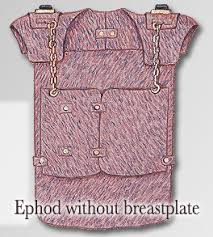Make the Ephod of Gold, Blue, Purple and Scarlet Yarn
28:6-14 and 39:3-7
Make the ephod of gold, blue, purple and scarlet yarn DIG: Whose names were to be engraved on the onyx stones? What would their names memorialize? What do these names suggest about the priest’s role in relation to the people of God?
REFLECT: What names would you engrave on a button or memorial to honor those whose faith has been a foundation of yours? Would your names appear on anyone else’s?

The high priest wore a loosely fitting jacket called an ephod that covered his upper body. It is a strange word to us. We don’t have any piece of clothing to compare to it. This was his third piece of clothing. It was worn over, and stood out in contrast to, the blue robe (Leviticus 8:7-8). Later in biblical history the ephod became the official emblem of the priesthood. Whoever had the ephod, had the priesthood (First Samuel 2:18, 14:3, 22:8, 23:6, 30:7-8).
The ephod was made out of material that looked similar to the inner veil of the Sanctuary. It’s importance lies in that it was made of blue, purple and scarlet yarn and of finely twisted white linen. The courtyard, the gate, the inner veil, the outer veil, and the covering of the Sanctuary were all made of this same material, which pointed to the purity of Messiah. It was made in two pieces, a front and a back that were joined together at the shoulders by two braided chains of pure gold. The two parts of the ephod were fastened around the body by means of a skillfully woven waistband, which was really of one piece with the ephod (28:6-8 and 39:3-5).

Two onyx stones were fastened in gold interlacing settings on the shoulders of the ephod. The onyx stones had been part of the people’s contribution to the building of the Tabernacle (25:3-7). The names of the twelve sons of Isra’el, in the order of their birth, were engraved on each stone – six names on one stone and the remaining six on the other. The rabbis teach that there were twenty-five letters on each stone. The two onyx stones were then mounted in gold interlacing settings and fastened to the braided gold chains. In that position, the stones would remind the high priest of his responsibility to faithfully represent each of the tribes as he officiated in the services of the Tabernacle. Two specialists – those of the skilled craftsman and the embroiderer – were required for making the inner and outer veils (26:31 and 26), as well as the priests’ garments (28:6, 15 and 39, 39:29), and a third – that of the weaver – became necessary as the work on the garments proceeded (39:22 and 27).624 The high priest bore the children of Isra’el on his shoulders, signifying his position as representative of the entire nation. His appearance served as a memorial before ADONAI (28:13-14).
What a better place for us to be carried than on the shoulders of the Great High Priest? Yeshua once gave a parable about lost sheep. He said: Suppose one of you has a hundred sheep and loses one of them. Does he not leave the ninety-nine in the open country and go after the lost sheep until he finds it? And when he finds it, he joyfully puts it on his shoulders and goes home. Then he calls his friends and neighbors together and says, “Rejoice with me: I have found my lost sheep.” I tell you that in the same way there will be rejoicing in heaven over one sinner who repents than over ninety-nine righteous persons who do not need to repent (Luke 15:3-7). The shepherd went out and found his lost sheep and put it on his shoulders. Jesus, carries me on His shoulders where He also carries you. From time to time I get off His shoulders, but He is right there to lift me back to safety. The ephod gives us a breathtaking picture of Yeshua Messiah.625



Leave A Comment